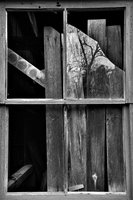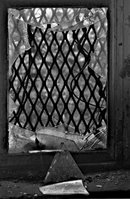 I am often asked, "What do you think about when you do photography?" To which I typically respond with something like, "the less the better." An answer which, unfortunately - more often than not - only leads to a protracted discussion (that my deliberately "short" reply is usually meant to avoid).
I am often asked, "What do you think about when you do photography?" To which I typically respond with something like, "the less the better." An answer which, unfortunately - more often than not - only leads to a protracted discussion (that my deliberately "short" reply is usually meant to avoid).
However, the truth is that while my reply is curt, it is far from flippant. Indeed, it conveys the very essence of what I love about photography. Apart from the signature theme of my blog ("Tao" / photography), and my lifelong predilection toward mysticism and spirituality, the one word - the one idea - that best describes what the "I" that the external world calls "Andy Ilachinski the photographer" experiences during (the most memorable moments of doing) photography is flow.
Here I am thinking of the word "flow" as defined by Mihály Csíkszentmihályi, director of the Quality of Life Research Center at the Drucker School of Claremon Graduate University, and author of (among many other books), Flow: The Psychology of Optimal Experience. In this book (and in his multi-decade long examination of the subject), Csíkszentmihályi describes the supra-conscious state (sometimes called the "groove" by musicians, or the "zone" by basketball players) that people "awaken" to and experience when completely absorbed and immersed in an activity. For me, of course, that "activity" is doing photography; or, more precisely, when I am out "shooting with my camera" (and eye/I).
When I write, as I do in some of my blog entries and Blurb books, that my best moments as an artist - as a human being - are those when I entirely lose a sense of self, I do not mean this to be interpreted as poetry or metaphor; I mean this literally. If I come home from a day's worth of a photo-safari, armed with 10 or more GBs of RAW files, and know that I was totally aware of what I was doing the entire time (consciously thinking of f-stops, filters, and compositions), I will also know that there will be little chance of finding any soulful art in that huge digital pile. I was not in the flow. On the other hand, if I go out for a walk with my dog and camera, and come back with but one shot of I know not what because my mind was lost while I was taking it, I stand a good chance of savoring that precious gem of an image that is likely to emerge on my computer screen. Not always, of course, but the chances are usually good, if I lost myself in the process of capture.
When I write, as I do in some of my blog entries and Blurb books, that my best moments as an artist - as a human being - are those when I entirely lose a sense of self, I do not mean this to be interpreted as poetry or metaphor; I mean this literally. If I come home from a day's worth of a photo-safari, armed with 10 or more GBs of RAW files, and know that I was totally aware of what I was doing the entire time (consciously thinking of f-stops, filters, and compositions), I will also know that there will be little chance of finding any soulful art in that huge digital pile. I was not in the flow. On the other hand, if I go out for a walk with my dog and camera, and come back with but one shot of I know not what because my mind was lost while I was taking it, I stand a good chance of savoring that precious gem of an image that is likely to emerge on my computer screen. Not always, of course, but the chances are usually good, if I lost myself in the process of capture.
This experience, and my interpretation of it, is far from unique. It is experienced by everyone, at some point in time, though not everyone is always attuned to when (or why and how) it happens, nor appreciates what needs to be done to maximize the chances of it happening again. This is where Csíkszentmihályi's books come in handy, as they describe the nature of this experiential flow; how it comes about, what the tell-tale signs are, and how one might better prepare for the "ride."
Hereis a wonderful 20 min long TED presentation by Csíkszentmihályi. A short excerpt from his book is available here.
Hereis a wonderful 20 min long TED presentation by Csíkszentmihályi. A short excerpt from his book is available here.
Csíkszentmihályi identifies 8 conditions / dimensions of the flow experience: (1) clear goals every step of the way; (2) immediate feedback to one's action; (3) balance between challenges and skills; (4) focused concentration; (5) sense of potential control; (6) loss of self-consciousness; (7) time distortion; and (8) autotelic or self-rewarding experience. Critically, in order to maximize the potential for experiencing flow, one must eliminate (as much as possible) any anxiety or boredom, and strike a delicate (and typically dynamic) balance between the challenge of the activity and the available skills that one brings to bear on the required tasks. The purest - or deepest - states of flow are achieved when one is able to apply a maximal skill set (which can itself, of course, be achieved only through long study and practice; i.e., a total immersion to craft) to the most highly challenging activity. This is rare, but is a spiritual prize well worth pursuing.
Among the several wonderful quotes that Csíkszentmihályi includes in a 2007 presentation ("Flow and Education") are these three: one from an anonymous rock climber...
“You’re so involved in what you’re doing, you aren’t thinking about yourself as separate from the immediate activity. You’re no longer a participant observer, only a participant. You’re moving in harmony with something else you’re part of.”
...one from a surgeon:
“You are not aware of the body except your hands...not aware of self or personal problems….If involved, you are not aware of aching feet, not aware of self.”
...and one from poet Mark Strand:
“You're right in the work, you lose your sense of time, you're completely enraptured, you're completely caught up in what you're doing…. there's no future or past, it's just an extended present in which you're making meaning…”
These sentiments pretty much express my own experience of flow in photography. When in the flow, I do not know my name, I do not know where I am except for the "feel" of my immediate surroundings, I do not reflect on my problems or station in life, I do not worry about what "I need to do" after I've finished my photography. I am one with my camera, I am one with what my camera is pointed at, I have no conscious sense of self or awareness of being, apart from a pure primal joy in experiencing total immersion in what I am doing. I am focused, strongly and deeply, but not at all actively engaged in thinking about anything. There is no sense of time, not even as I press the shutter repeatedly or take long exposures and somehow, though only mechanically and utterly devoid of conscious reflection, tick off the required seconds. I know the flow has vanished when I hear myself ask, "What now?"
Interestingly, Csíkszentmihályi's research suggests that it is highly unlikely that individuals will attain a sense of flow - in any field or endeavor - unless they've immersed themselves in it for at least 10 years. I can attest to this being true in my case, though (being a bit slow perhaps;-) it took me nearly twenty to reach this state. But, oh how I look forward to that precious, wondrous experience when it comes! Alas, when I am one of those (much, much more frequent) non-flow states, the best I can do is recall having the flow experience, not the flow itself. But I know it will come...
So, "What do you think about when you do photography?"











